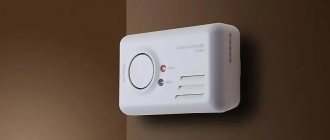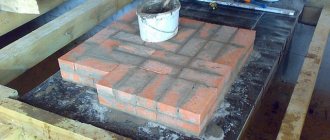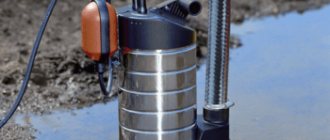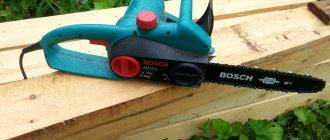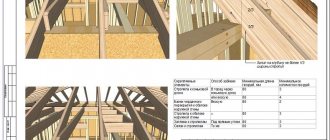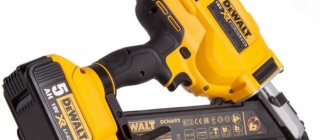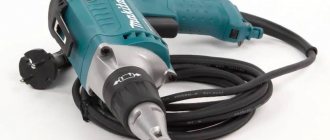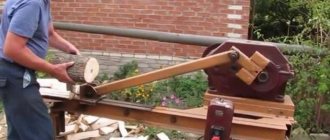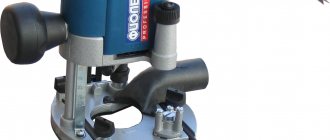A power-driven carpentry tool used to level wood surfaces is called a power planer. This device facilitates the work of the master when performing planing work of various types of wood along, across and at an angle to the direction of the fibers. Before you buy an electric planer for your home or garden, it’s worth understanding its types, how it works, and what criteria you should use to choose this tool. Indeed, on the modern market there is a fairly large selection of electric planers of various brands and models.
Main features and types of electric planers
Unlike similar manual mechanical tools, which require the worker to apply quite a lot of effort, an electric planer has many advantages. This tool:
- makes work easier, since work does not require excessive physical force;
- increases productivity due to the presence of an electric drive;
- increases the accuracy and cleanliness of surface alignment;
- has a number of additional functions that allow you to remove a neat, uniform chamfer or make a quarter cut, that is, removing solid wood of the required size along the edge, which is very difficult to achieve with a conventional mechanical plane.
Among the features of the electric planer is its highly specialized focus. With this tool you can perform only a certain type of work on one single material - wood. Therefore, the greatest need for it arises among people involved in wood processing and the manufacture of wooden products. And in the arsenal of an ordinary home craftsman you can rarely find it.
If you need an electric planer, you should understand that the productivity and quality of work performed by it will depend on the compliance of the technical characteristics of the device with the tasks for which this tool is purchased. You need to pay special attention to this when choosing an electric planer.
Today you can find several types of electric planers on sale, namely:
- manual with commutator motor
This tool uses a commutator motor.
or stationary - with asynchronous.
The asynchronous motor used in the tool has larger dimensions and weight than the commutator motor, which affects the size of the machine - network, operating on 220 volts
The tool works only from the networkor battery-powered, which do not require connection to a household electrical network (usually an 18-volt battery is used);
These devices use an 18 volt battery. - professional or household, differing in power and other technical characteristics.
Table of contents
5. Labeling, packaging, transportation and storage
Appendix (recommended) Double Knife Parts Structural Components
| Date of introduction | 01.01.1982 |
| Added to the database | 01.10.2014 |
| Expiration date | 01.11.1989 |
| Update | 01.02.2020 |
Organizations:
Jacks for planes. Specifications
For free
download this document in PDF format, support our site and click the button:
STATE STANDARD OF THE USSR UNION
Design and principle of operation
The design of any electric planer is simple and straightforward, if you do not delve into the design of the electronic speed control system. Even externally, all hand-held tools are similar to each other, and consist of the following basic elements:
Design diagram of a manual electric planer
- Front movable support with adjustable height.
- Aluminum housing with removable belt gear housing.
- Front handle with planing depth adjuster.
- Electric motor of commutator type.
- Trigger with safety button against unintentional activation.
- Rear handle.
- Fixed rear support plate.
- A drum with knives attached to it. In most cases there are two knives, but there are models with more of them.
Bottom view of the electric planer. Three longitudinal grooves for air removal are visible on the sole - Aluminum smooth sole with a longitudinal slot for air removal, providing better surface treatment. There may be two or three such grooves.
Some models of electric planers have a chip discharge pipe, to which a vacuum cleaner hose is connected, as well as removable parallel stops for adjusting the cutting width.
Some models have a chip outlet and removable parallel stops
The operating principle of an electric planer is quite simple. Its working body is knives mounted on a drum. While moving along a wooden surface with the engine turned on, torque is transmitted through a belt reducer to the drum, and the knives cut off the top layer of wood. In this case, the thickness of the chips is set by the difference in height between the moving and stationary parts of the sole of the electric planer.
The planing depth is determined by the difference in height of the rear and front soles of the electric planer
The planing depth is adjusted using a screw combined with the front handle of the tool. To obtain a high-quality, even surface, the electric planer must be moved at a uniform speed. Moreover, its power must be at least 600 - 900 W, and the rotation speed of the knife drum must be from 10 thousand rpm. The operating principle of the electric planer is presented in more detail in the following video.
Video: how to use a plane
Figure planing
Figure planing on wood is an art. To create unique products with a profile section, it is necessary to use a special material - wood of the highest quality, which must have a minimum number of knots, and it itself must be straight-grained. At the same time, such high-quality material must be processed with a special-purpose tool. Such tools may include:
- Kalevka - this type of plane is used for shaped processing of objects. It has a multi-level sole and special edges on the knife. Perfect for making carved door/window trims, baguettes and cornices.
- Tongue and groove - used for making grooves, holes in boards and tongue and groove joints, as well as other tongue-and-groove joints. Consists of securing and guiding blocks held in place by screws.
- Primer – it is designed for cleaning grooves in the form of a trapezoid along the grain of the wood.
- Zenzubel - it is used for making grooves and quarters and then cleaning them. The knives of this device are shaped like blades, and the body is equipped with a special hole for discharging chips.
- Falzgebel - used for stripping and selecting quarters, has a stepped sole.
- Humpback - its plantar base has a convex shape, which is very convenient for working with cylindrical, semicircular or concave surfaces.
How to choose the right electric planer: basic criteria
In order to choose the right electric planer from the wide variety of existing models, you must first decide on the mode of its use. If you need a tool to regularly perform woodworking work, you need to buy a professional electric planer. For occasional use at home, a household power tool will be sufficient.
The main characteristics and parameters that must be taken into account when choosing an electric planer include:
- engine power, which can range from 0.5 to 2.2 kW;
- planing width, determined by the length of the knives (models with knives 50, 75, 82, 100 and 110 mm are available).
- planing depth equal to 0.1 - 2 mm for household tools and up to 4 mm in increments of 0.1 for professional ones;
- rotation speed of the knife drum (in different types of electric planers it ranges from 10 to 18 thousand rpm);
- weight of the tool - household electric planers weigh 2.5 - 4 kg, and the weight of professional ones reaches 9 kg.
For use at home or in the country, for small volumes of work, you need to choose an electric planer with a motor power of up to 1 kW, a planing width of 82 - 110 mm, and a rotation speed of 10 - 12 thousand rpm. The longer the knives, the fewer passes the tool will need to make to process a wide board. This means that the quality of its surface will be better .
In addition to technical characteristics, when choosing an electric planer, you should pay attention to such important details as appearance and some design features. The ease of use of a power tool and the quality of its work can be significantly affected by:
- Electric planer sole. It should be absolutely smooth, and have V-shaped longitudinal grooves (1 - 3 pieces) on the front, height-adjustable platform. After all, the air cushion formed during work does not allow you to remove chips of the same thickness. It would be good if there was a plastic stop at the back of the stationary half of the sole, which would serve as protection for the treated surface.
Single flute tool model
Some models have two or three grooves on the forefoot
The support on the back sole protects the treated surface
- Handles, of which there must certainly be two, to make it more convenient to move a tool of considerable weight over the surface being processed. The main requirement for them is the presence of a convenient ergonomic shape, as well as the location of the starter and lock buttons so that you can easily reach them without letting go of the handles of the electric planer. It would be good if the tool handles had rubberized pads, which would provide a more secure grip and prevent your hand from slipping.
- Blade adjustment screw. It is better to buy an electric planer with internal notches on the adjustment mechanism, which is combined with the front handle, so as not to accidentally reset the planing thickness setting. If you choose a tool with an external notch to adjust the chip thickness during operation, then you need the scale on the screw to start with negative values. After all, some planes remove chips even at zero setting.
- Knife protection. A folding guard or automatically ejected foot protects more than just the worker's fingers. but also the treated surface from contact with knives.
- Chip ejection. It must be provided in the design of the electric planer, because shavings clog the working surface. It is desirable that it be possible to remove chips in both directions on the sides of the tool, which is convenient for right-handed and left-handed people.
Using a switch, the chip discharge pipe can be extended to the right or left. - Tool kit. It is best to choose an electric planer that comes complete with necessary accessories such as parallel stops or a side stop with a depth gauge. This will expand the functionality of the device, allowing you to process narrow edges or make quarter cuts. Some models include equipment that allows you to fix the electric planer motionless in an inverted state, turning it into a mini planer. This is convenient when processing long workpieces.
Tools make it easier to pick out quarters
It is advisable to choose a tool equipped with stops
Transformation of an electric planer into a machine is convenient for processing long lumber
An equally important criterion is the price of electric planers. For home use, more budget models of medium power with a set of the most necessary functions are quite suitable.
Choosing a mechanical hand plane
Before choosing a tool for carpentry, you need to understand that woodworkers rarely get by with just one type of plane. When purchasing, you need to decide what exactly a particular device is for. It is always better to choose a standard size tool, and if you need it for more delicate work, purchase it separately. If a young craftsman or student is learning the craft, then you still need to take a regular-sized plane, but small sizes require skill that has not yet been developed.
As for the block material, cast iron is preferable for it. It is wear-resistant and glides easily. An ordinary metal block can easily become deformed if it is accidentally hit or the force is miscalculated.
As for the weight of the instrument, you need to decide on your own preferences. If there is not a lot of work, then it is better to choose a heavier tool. The quality of work with it is excellent, the accuracy of movement will be high. Just remember to take breaks to recover when working with a larger instrument.
Before buying any instrument, it is better to hold it in your hands, carefully examine it, and check it. Of course, based on visual inspection alone, it is difficult to be sure of the quality of the product, but some flaws can still be noticed, as well as defects.
First of all, you should pay attention to the flatness of the sole of the pad. She must be perfect. It may be rough, it's not a big deal. But it shouldn't be crooked. How to check? When choosing a plane, use a metal ruler. In a well-lit place, turn the plane over and start placing it edge-on to the sole. Carry out this check in all directions. The flatness of the shoe sole determines the quality of planing.
For sharpening, if you don’t already have one on your farm, purchase a wide (wider than the plane iron) whetstone. The most convenient is the one that has different grain sizes on different sides.
Of course, any business requires learning. But gradually, as you get better at it, your skill will grow. Pay attention to the video, watch it, it will help you in choosing the first model.
Professional carpenters advise focusing on such details as:
- sharpness of knives - sharpening quality is of paramount importance,
- wide gap - chips will come out easily and quickly,
- convenience of the model - try the plane in your hands, this particular design should be comfortable for you, because a long period of work should not tire you,
- the ability to adjust the inclination of the knife blade - this type of plane is more universal, because for different types of work the angle of the knife is different,
- manufacturer's brand - this information can be gleaned from the video above.
Which brands and models are best to choose?
When choosing an electric planer, the brand and model of the tool are of great importance. Products from more well-known brands are in increased demand and popularity compared to cheap Chinese products. Despite the higher cost, branded power tools continue to be in demand due to their reliability and quality.
Among the most well-known brands that are constantly in demand among consumers, both for home workshops and for professional use, the following brands can be named:
- Bosch from the German manufacturer, the Robert Bosch GmbH group of companies, which has production all over the world;
- Makita, owned by the Japanese corporation of the same name, which is famous for high-quality professional power tools;
- De Walt and Black & Dekker, produced by the same company Stanley Black & Decker, Inc. from USA;
- Hitachi from Japan;
- Interskol from a Russian manufacturer;
- Sparky, a brand from Germany, whose products are manufactured in German factories and in Bulgaria.
When choosing an electric planer, you should pay attention to the country in which it was assembled. Products of original origin have the best quality, reliability and durability . Unfortunately, on the modern market you can find Chinese counterfeits of well-known brands not only of Western companies, but also of Russian origin. These models even have Russian names “Grad” or “Bison”, which often confuses the buyer. You should immediately decide, so as not to run into a cheap fake, that it is better not to consider an electric planer costing up to 3 thousand rubles as an option for purchase.
The most popular models include the following.
Bosch GHO 15–82 , with a planing width of 82 mm, which belongs to the category of professional tools, but is lightweight (2.5 kg) and designed for finishing work. With this planer you can select a groove up to 9 mm, and with the help of the accessories included in the kit, transform the hand tool into a convenient planer. According to customer reviews, it is good for large volumes of work. But it is recommended to buy only an original German device or a European-assembled product.
“I purchased a bosch gho 15-82 plane. The test of planing 102 m2 of boards was passed perfectly. In general, I worked without a smoke break for almost half a day non-stop.”
Pavel Pavlovich
https://forum.woodtools.ru/index.php?topic=39094.0
Electric planer for finishing work
Makita KP 0810 C , equipped with a soft start system. ensuring a clean start to the cut. This tool has high productivity, given the optimal ratio of time and roughing area. According to user reviews, the electric planer of this model does a good job of chamfering and removing quarters.
An ideal plane for cutting quarters and planing narrow products. It removes chamfers very well with the help of a special stop, which I purchased separately. Assembly Japan.
Sergey
https://www.220-volt.ru/catalog-30830/0/0/
Equipped with a side rip fence and soft start system
Bosch GHO 40–82 C 0.601.59A.760 has a comfortable, ergonomic design with high-quality assembly. The presence of electronics allows for a smooth start and a clean surface finish when planing hardwood boards. Not very suitable for processing timber and large volumes of work, due to the presence of only one blade on the drum, which will have to be changed frequently. But the machine is suitable for home use. Blades are changed quickly and easily. The tool is supplied with 10 interchangeable knives; together with the key required for replacement, they are attached directly to the body of the electric planer. According to customer reviews, this model is very easy to use.
Small, light, rarely clogged even when he was given full depth. The fact that there is one knife is even better - savings. The knives are incredibly easy to change and you don’t need to make any additional adjustments.
257 BalBes
https://www.forumhouse.ru/threads/115827/
I have a Bosch 40-82. Knives get dull pretty quickly. Otherwise, it's an exceptionally nice unit.
Hippopotamus
https://www.forumhouse.ru/threads/115827/
Hardwood Tools
De Walt D 26500 K . This model is ideal for processing any wooden surface, including hardwood. Quartering and chamfering functions are available. When working, the tool makes little noise. With its help you can process boards and bars that are not too wide. The device has an electronic soft start system and can also be transformed into a machine.
The impressions are positive, before the purchase I was tormented by only one doubt, there is a lot of information on the Internet about problems with the support heel, as it turned out, all this is a little untrue, there is nothing wrong with the heel, but it does not work according to the same principle as other planes. I was also pleased with the set of planer, a suitcase, a bag for collecting chips, a nozzle for a vacuum cleaner, a guide ruler, a depth limiter for cutting a quarter, a key for replacing knives - this set is additional. accessories will not hurt. The power of the plane is beyond the eyes, it calmly takes larch to a depth of 4 mm, there is no drop in speed as such (of course they decrease under load, but this is not noticeable) The plane does not overheat.
Dimon14
https://www.forumhouse.ru/threads/205239/
Designed for large volumes of work with any type of wood
Interskol R-102/1100EM is an inexpensive but functional and convenient electric plane with a wide sole (102 mm), designed for processing wide beams and boards with an uneven surface. It has the function of removing quarters up to 15 mm, and is suitable for large volumes of work. The model is interesting due to the presence of a soft start, adjustable rotation speed of the knife drum and a system for maintaining a certain number of revolutions under load. This tool is ideal for home and garden use, and has a lot of positive reviews from consumers.
The Interskol R-102 plane, in my opinion, is the most optimal choice both from the line of planes from different manufacturers, and among planes from the Interskol company. If you take a tool for the home, then there is no point in overpaying almost double or even triple the cost for Makita or Bosch, Interskol R-102 will last you until you want to buy a new one. Unlike its Interskolov brothers, the R-102 is equipped with overheating protection, which means that it is almost impossible to burn, the smooth start of the device reduces the chances of injury and increases the service life of the engine. The 1200 W engine easily planes even complex rocks wood, and with a knife 102 mm wide it is very convenient to process ten-bar timber. It is a pity, of course, that the R-102 was not equipped with a stationary unit like its brothers, but for me this turned out to be a solvable problem, I built it myself!
IKSA22
https://otzovik.com/review_409076.html
Video: how the electric plane Interskol R-102/1100EM works
Cordless tools
Using a power tool, including a plane, requires connecting it to an electrical network. which requires a certain connection between the work site and the existing electrical wiring. Of course, if you are far from connection points, you can use extension cords, but this brings with it some inconveniences. The way out of this situation is battery-powered electric planers. Externally, they are no different from conventional similar devices, except for the presence of a battery and its connection point, which are located on the rear vertical stand, behind the handle. Most of these electric planers operate on 18-volt batteries, but there are models designed to use a 14.4-volt battery.
The battery socket is located on the rear pillar, behind the tool handle
Today, cordless planers are produced by almost all power tool manufacturers. This is due not only to their ease of use, which does not require connection to power distribution points, but also to a certain fashion for cordless tools. Battery-powered electric planers have similar characteristics, design and functionality to corded tools. Only their cost is significantly more expensive, therefore, in the absence of the need to carry out constant woodworking work far from sources of electricity, the purchase of such a plane is not economically feasible.
GOST 1183-80 Knives for planes. Specifications
Buy GOST 1183-80 - a paper document with a hologram and blue seals. more details
We have been distributing regulatory documents since 1999. We punch checks, pay taxes, accept all legal forms of payment without additional interest. Our clients are protected by law. LLC "CNTI Normocontrol"
Our prices are lower than other places because we work directly with document providers.
Delivery methods
- Express courier delivery (1-3 days)
- Courier delivery (7 days)
- Pickup from the Moscow office
- Russian Post
Applies to planer knives: sherhebel, single, double, tsinubel, zenzubel and folded.
Reissue (December 1983) with revision No. 1
Safe work rules
The working element of an electric planer is sharp knives mounted on a drum rotating at high speed. This unit poses the main danger to the person working with the tool. Therefore, you should follow simple rules for safe handling and work with an electric planer, namely:
- work clothes should not have long, hanging sleeves;
- Before starting work, you need to make sure that the tool is in good working order and that the knives are securely fastened to the drum; this should only be done when the power cable is disconnected from the network;
- if necessary, clean and adjust the tool without plugging it in;
- before starting work, check the surface to be treated for the presence of nails or screws;
- When working, be sure to wear safety glasses to protect your eyes from chips;
- the workpiece must be securely fixed on the work table using a vice, clamps and other devices;
- It is allowed to use only those blades that are recommended by the tool manufacturer;
- do not leave the electric plane connected to the network unattended;
- store the instrument out of the reach of children.
Following these simple rules will help protect you from painful injuries and injuries.
FAQ
Where are the knives of an electric planer attached? The working element of any model of an electric planer is a shaft or drum. It is in it that there are special shelves with fasteners where cutting blades are inserted. Depending on the brand, there are slight differences in the position of the knives, which it is advisable to familiarize yourself with before directly replacing the blades.
How does an electric planer work? After the electric motor starts, the drum with installed cutting blades/knives rotates at high speed. At each half-turn of the drum, the knife selects a certain array of wood. Thus, an even layer of wood is cut at high speed.
Is it possible to sharpen knives for an electric planer yourself? In principle, it is possible, but if you have special skills and the appropriate tool. Otherwise, the blades may differ in width, which will lead to a decrease in the quality of wood processing.
Typical malfunctions and methods for their elimination
Among the typical, particularly common malfunctions of electric planers, the following can be noted:
- sparking of the electric motor, which can occur due to wear of the commutator brushes, poor contact in wire connections or mechanical wear (damage) of the shaft;
- wear of the blades, which causes tool overload and can lead to engine failure;
- wear or rupture of the belt transmitting torque from the engine shaft to the knife drum.
It is better to entrust electric motor malfunctions to professionals who can diagnose the motor and determine the cause of the sparking. Replacing the commutator brushes alone may not do anything. Other typical faults can be fixed yourself.
The knives of the electric planer are mounted on the drum in special grooves; to replace them you must:
- Disconnect the tool from the power supply.
- Set the planing depth regulator to “0”.
- Having manually turned the drum so that there is access to the three knife mounting bolts, use a wrench of the required size to loosen the nuts of the bolt connection.
- Remove the blade clamp from the groove;
- Disassemble the clamp, removing the worn blade from it;
- Insert the new blade into the clamp and reassemble in the reverse order;
- Repeat all procedures for the second blade.
The process of changing knives is presented in more detail in the following video.
Video: replacing knives on an electric planer
After replacing the knives, adjust them. To do this you need:
- By placing a ruler or corner with its edge perpendicular to the cutting line, resting against the back and front of the sole, we determine whether the tip of the knife touches the ruler. On both the right and left sides, the knife should be in equal contact with the control ruler. This will ensure uniform chip removal across the entire planing width.
- If both planes of the sole and the tip of the knife are not on the same line, you need to loosen the bolts.
- Using the hex key included with the tool, you need to set the desired height of the left and right sides of the knife, as shown in the video below.
- Having reached the desired level, tighten the bolts.
Video: setting up knives
The belt must be replaced in the following order:
- Disconnect the power cable from the electric planer.
- Remove the protective cover.
- Loosen the fastening screw on the pulley;
- Remove the belt and install a new one in its place.
- Reassemble the tool in reverse order.
